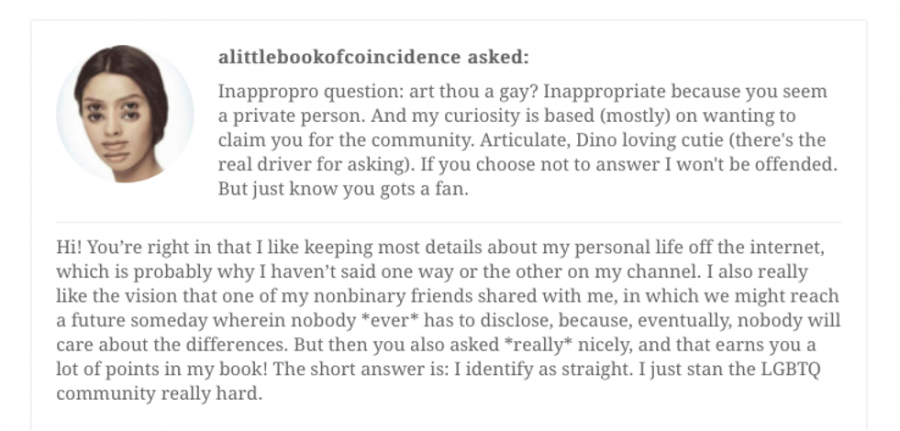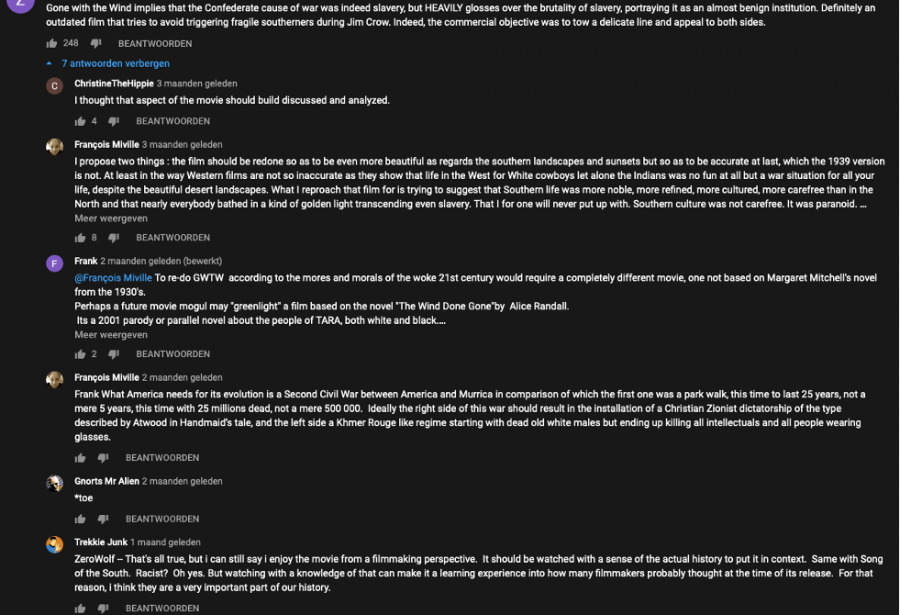
Gone with the wind, Discourse, Infrastructure and Hegemony
Through the debate on cultural representation in media, the movie “Gone with the wind” has been a topic of controversy. This movie was released in 1939 has been accused of propagating lost cause mentality. Lost cause mentality is a sympathetic view to the Confederate states of American, which somewhat glorifies it. (Gallagher & Nolan, 2000) Now I will give a general overview of the movie. It takes place during and after the American civil war. The lead character, Scarlet O’Hara, is a slaver. And many characters in the movie are sympathetic to the southern cause.
The discourse I will analyze mainly discuses wether to watch the movie or not. To analyze this entire discourse would be impossible in this analysis. Thus I chose to look at a set of Youtube video’s and their comments. I will focus on the discourse that is displayed here. By analyzing this I will uncover that this discourse is hallmarked by hegemony.(Blommaert, 2005)
Theoretical framework
The tools that I will use to analyze my data will be identity repertoire and linguistic landscaping. This all will converge in a study of hegemony in this discourse. Part of this hegemony will be understanding intertextuality. This study will to an extant be multimodal as video and textual data will be combined. In this I will use the 3 arrows (forward, backwards and sideways) of linguistic landscaping. My two data sets will be analyzed from these three angles. A set of youtube video essays that discuss wether to watch this video and the comment sections under them are the data.(Blommaert, 2013)
Video
First of all I will discuss the video’s themselves. They form one whole however they can be seen as separate parts. One mainly elaborates on the movies history and the general history of southern lost cause mentality while the other video actually tries to answer the question of wether folks should still be watching “Gone with the wind”.
Now I want to address the three arrows. The video was produced by a YouTuber and film studies major who goes by the alias ColdCrashPictures. He does in depth critiques of many movies and has confederate heritage himself. He expresses a lot of progressive positions such as supporting LGBTQ+ people as is perceivable in the following picture. The bottom text is ColdCrashPictures’ quote on supporting the LGBTQ+ cause.

Example of the author showing liberal sentiments
The video is clearly meant for an audience with some experience in western culture. He uses a lot of references to other media such as music. Furthermore to get the full point the format of a video essay has to be familiar to a person as does the general political landscape of the USA with some knowledge of US history included. He uses cultural material and references US history without explaining. For instance, he mentions but does not explain terms like Yankee and confederate. He also uses music like “Fuqboi” by Hey Violet to get across meaning. These can only convey anything is the audience understands the references. Uptake is thus dependent on understanding certain repertoires and knowledge of history. (Blommaert & Varis, 2015) (ColdCrashPictures, 2019)
Because the video is on Youtube both acces to infrastructures and the right filter bubble are neccesary to easily acces it.
Finally the specific emplacement is on Youtube. This means that certain populations are less likely to see the video. Two main reasons for this seem obvious. First of all digitally illiterate or people with a lack of digital infrastructures can not be reached. Secondly the filter bubble phenomenon(Sunstein, 2017) makes this video recommended for some and not for others. A filter bubble is what happens when content providers start showing a user only specific content based on algorithms and their previous behavior. An example of this is the YouTube recommendation system. Your previous watching behavior influences what is recommended. Thus everyone only sees what they are likely to connect too. Thus people who have shown interest in related videos and topics are more likely to see this video. (Sunstein, 2017) (ColdCrashPictures, 2019)
Comments
Now I will analyze the comments on the video’s. This is where after seeing the argument laid out people continue the debate. To illustrate this discussion I will now show an example of a such a discussion. I will start with the semiotic scope.

Excerpt of Comments section

Commenter using references without explaining

Commenters judging other commenters behavior based on hegemony
Another example of this can be found above. The person in the comment above calls people out for not watching the video before commenting. This shows that the action of not following this rule is considered deviant. Watching the video first would be normal in this group. That rule is hegemonic. It is not questioned in any other comment Many people liked this comment. Thus commenting before watching the video makes an individual deviant. If people do not know how to act in this comment section they will be chastised for doing so. This means one must be familiar with the norms of this group to be non-deviant. (Blommaert & Smiths & Yacoubi, 2018) (Becker, 1963)
After addressing the semiotic scope of the comments I will now address the spacial scope. These comments are intrinsically emplaced under a video. Thus again access to infrastructures and digital literacy are required to join this debate. Furthermore, filter bubbles impact whether this video will be recommended for a certain person. With the amount video’s that are on youtube, it is pretty hard to find video’s if they are not recommended for you. Thus if people are not recommended this video, it is hard for the to access it or its comments. Only then can they join the discourse.
Knowledge is neccesary to particpate in the discussions
This filter bubble, is influenced by previous behavior such as viewing patterns. People usually watch video’s that they find interesting. Your recommended videos will thus be similar to ones you previously watched. Thus this video will likely be shown if you are interested in it. This means most people who watch it will have interest in the subject. People often have knowledge about things they are interested in. The filter bubble could thus already select an audience with certain knowledge. This is because not only viewership of as previously concluded but also engagement with the video is impacted by the Filter Bubble phenomenon. (Sunstein, 2017) (Blommaert & Maly, 2014)
In summation, in these comments there are preconceptions almost all commenters share. Thus they share hegemony. The commenters know how to act when using this platform in this chronotope. Thus they have an identity repertoire. Communicative repertoires, but also knowledge and opinions are part of this. In short we can sense a shared Hegemony. This informs an identity as a valid member of the conversation.(Becker, 1963)(Blommaert, 2005)
Conclusion
Thus to participate in this discourse one needs the hegemonic knowledge. One needs to understand the intertextuality, norms and how to work with youtube. People adopt an identity repertoire. This is perceivable in all three arrows of the data. The addressers, produce the comments and video with this knowledge. The audience needs this knowledge to interpret. It is a condition for uptake. Furthermore the video is emplaced within barriers. Filter bubbles make sure people with interest and thus likely knowledge about the topic can more easily access it. Digital literacy ensures that only people with specific skills in digital media can access this video.
References :
Becker, H(1963) Outsiders: studies in the sociology of deviance. The Free press, New York, New York, United States of America.
Blommaert, J.(2005), Discourse. A Critical Introduction. Cambridge University Press. The Edinburgh Building, Cambridge CB2 2RU, UK
Blommaert, J, (2013) Semiotic and spatial scope: Towards a materialist semiotics. In Book. Multimodality and Social Semiosis. Communication, Meaning-Making, and Learning in the Work of Gunther Kress.
Blommaert, J. Maly, I(2014)Ethnographic linguistic landscape analysis and social change: A case study , Tilburg University
Blommaert, J. Varis, P.(2015)Enoughness, accent and light communities: Essays on contemporary identities. Tilburg University. Papers in culture studies, 139.
Blommaert, J. Smits, L. Yacoubi, N. (2018)Context and its complications. Tilburg University.
Eriksen, T(2007) Nationalism and the Internet. University of Oslo, University of Amsterdam.
Gallagher, G. Nolan. A(2000) The Myth of the Lost Cause and Civil War History. Indiana University Press.
Israel, J, (2010)A REVOLUTION OF THE MIND Radical Enlightenment and the Intellectual Origins of Modern Democracy, Princeton University Press, 41 William Street, New Jersey, United States of America.
Sunstein, C.(2017) #Republic. Princeton University Press.41 William Street, Princeton, New Jersey, United States of America.